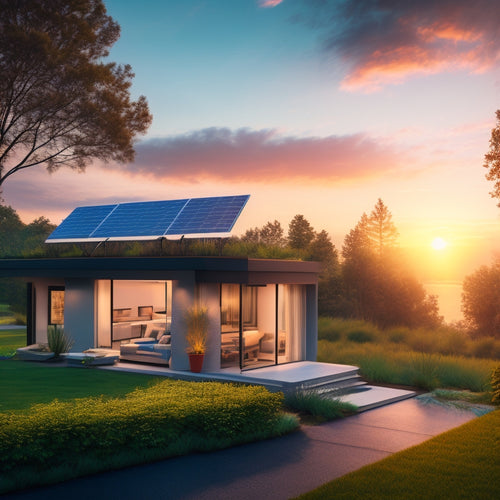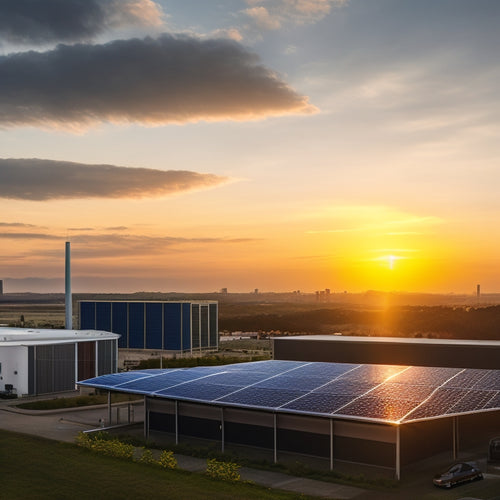
3 Key Off-Grid Power System Design Tips
Share
When designing an off-grid power system, you'll want to start by evaluating your energy needs accurately, considering factors like total wattage, daily energy usage, and seasonal variations. Next, select the right solar panel size by analyzing panel efficiency, optimizing orientation, and accounting for peak sun hours and shading. Finally, balance power and storage by verifying energy storage capacity, implementing load management, and calculating daily energy needs to determine required battery capacity. By following these three key tips, you'll be well on your way to creating a reliable and resilient off-grid power system that meets your unique energy needs, and there's more to investigate to guarantee your system is optimized for maximum performance.
Overview
- Conduct a thorough load analysis to accurately determine total energy needs, including daily usage and peak surge requirements.
- Select solar panels with high efficiency and optimize orientation for maximum energy output, considering location and seasonal variations.
- Balance power and storage by verifying energy storage capacity, implementing load management, and selecting suitable battery type and depth of discharge.
- Consider critical loads requiring continuous power supply and design the system for reliable energy independence and resilience against power outages.
- Factor in energy audits, peak sun hours, and shading to ensure the off-grid power system meets daily energy needs and provides desired autonomy levels.
Assessing Energy Needs Accurately
When designing an off-grid power system, accurately evaluating your energy needs is essential to guaranteeing a reliable and efficient supply of power. You need to determine your energy consumption patterns to size your system correctly.
Conduct a thorough load analysis to identify the total wattage required to power your appliances, lights, and other devices. Calculate your daily energy usage in watt-hours (Wh) and peak surge requirements.
Consider factors like seasonal variations, occupancy rates, and your desired level of autonomy. Be certain to account for any critical loads that require continuous power.
To guarantee accurate load calculation, create an energy profile listing device power ratings and daily usage hours, and consider device efficiency and potential system losses in calculations.
Selecting Right Solar Panel Size
Size up your solar panel requirements by factoring in your energy needs, location, and system design.
You've assessed your energy needs, now it's time to determine the ideal solar panel size. Consider the solar panel efficiency, as higher efficiency panels produce more power per unit area.
Panel orientation is also essential, as it affects energy output. A south-facing orientation typically yields the most energy.
Calculate the required panel size based on your energy needs and the amount of sunlight your location receives. To guarantee accurate calculations, conduct energy audits to analyze usage patterns and identify inefficiencies energy audits.
Furthermore, consider peak sun hours (PSH) to determine the required solar panel capacity. Don't forget to account for seasonal variations and potential shading.
Balancing Power and Storage
With your solar panel size determined, it's vital to balance power and storage to guarantee a seamless and efficient off-grid power system.
You need to verify your energy storage capacity can handle the power output of your solar panels. Proper load management is key to achieving this balance.
By accurately calculating your daily energy needs, you can determine the required battery capacity. It's important to take into account power calculations and battery capacity to minimize energy waste and verify peak system performance.
Focus on maximizing battery efficiency by selecting the right battery type, such as one with a suitable depth of discharge (DOD), and verifying peak charging and discharging cycles.
A well-designed power and storage system will provide you with reliable energy independence, giving you the freedom to live off-grid without worrying about power outages.
Frequently Asked Questions
What Is the Ideal Distance Between Solar Panels and the Battery Bank?
When placing solar panels, you'll want to minimize distance to the battery bank to reduce energy loss; ideally, keep them within 10-15 feet to optimize panel placement and maximize battery efficiency, ensuring you get the most out of your off-grid power.
Can I Use a Generator as a Backup Power Source?
As you seek independence from the grid, you're wise to contemplate a generator as a backup power source; you'll find that diesel, gas, or propane generator types can enhance backup efficiency, ensuring your freedom from energy uncertainty.
How Often Should I Inspect and Maintain My Off-Grid System?
You'll guarantee system longevity by establishing a maintenance schedule, inspecting your off-grid system regularly, typically every 3-6 months, to check for worn components, corrosion, and performance issues, and addressing them promptly to prevent unexpected failures.
What Are the Benefits of Using a Charge Controller With Mppt?
You'll maximize your off-grid system's efficiency by using a charge controller with MPPT, as it optimizes energy harvesting, reduces power loss, and increases battery life, giving you more freedom and independence from the grid.
Can I Add More Solar Panels to My Existing Off-Grid System?
You think you can just slap on more solar panels and call it a day? Think again! You'll need to verify the new panels are compatible with your existing system and don't exceed its capacity, or you'll be left in the dark.
Ready to Buy
By following these 3 key off-grid power system design tips, you'll be well on your way to utilizing renewable energy like a conductor leading an orchestra. Evaluating your energy needs accurately, selecting the right solar panel size, and balancing power and storage are essential to creating a harmonious system that runs smoothly and efficiently. With these tips, you'll be able to design a system that's customized to your specific needs, ensuring you stay powered up and connected, even when the grid is far away.
Related Posts
-

The Future of Residential Energy Storage
The future of residential energy storage looks promising and cost-effective for you. With lithium-ion battery prices ...
-

Replacing Old Appliances With Sustainable Alternatives
Replacing old appliances with sustainable alternatives can change your home into an energy-efficient space. Not only ...
-

Advantages of Commercial Solar Battery On-Site Storage
By investing in a commercial solar battery on-site storage system, you can greatly reduce your energy grid dependence...


